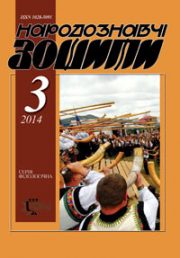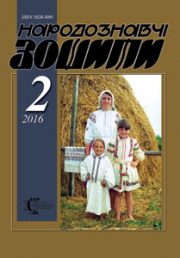The Ethnology Notebooks. 2019, № 6 (150), 1482—1487
UDK726.03.04:27-523.42-035.3](477.5)”18″
DOI https://doi.org/10.15407/nz2019.06.1482
MAZUR Viktoriya
ORCID ID https://orcid.org/0000-0003-1365-7581
Ph.D History of Arts, Dean of the Faculty of Theory and History of Art, National Academy of Fine Art and Architecture
Voznesenskyj lowering, 20, Kyiv, 02000
e-mail: mazur_viktoria@ukr.net
Abstract. This article is devoted to some aspects of decorative wood carving in the internal space of wooden churches of the orthodox Nadrossya of the XVIII century.
The aim of the research is to study and define iconographic and stylistic features of the decorative art object in the wooden church decoration of an unknown Church of the Orthodox Nadrossya. This is only the beginning of the research. The art object can complement existing artefacts available for scientific research on the decorative carvings of the XVIII century in the Central region of Ukraine. The combination of arts in the decoration of wooden churches is one of the most prominent and unique artistic phenomena. Despite historical circumstances of the state development, today we have unique wooden architectural landmarks with decorations that have been little studied, which is typical for the whole territory of the Central region of Ukraine. It is worth nothing that in this region, few examples of wooden architecture of the XVIII century survived, and even fewer objects of decorative and fine art are preserved in situ. Due to their poor condition and rarity, we have to take into consideration the inability to generalize. However, we can proclaim some significant results of the research work. In addition, in the process of the research, there are difficulties in outlining trends in the development and stylistic features of decorative art works belonging to the wooden temples of the countryside.
Thus, an object of wood carving art of Central Ukraine of the 18th century is introduced into scientific circulation — the Holy doors of the iconostasis of an unknown Church of the Orthodox Nadrossya of the XVIII century. On the basis of the research, the tasks were set: tо draw attention of the academic community to the art research of the newly discovered unique decorative art monument. The work proposed for publication is a part of the results of the research on the development and modification of decoration of wooden church architecture on the territory of Central Ukraine in the XVIII century. A consistent analysis of the material proves that today we have an ancient artefact that we dare to attribute to stylistic features of the XVIII century.
Keywords: interior of the church, the Holy doors, combination of arts, decoration of the wooden church.
Received 21.11.2019
REFERENCES
Dragan, M. (1970). Ukrainian decorative carvings of the 16th—17th centuries. Kyiv: Naukova dumka [in Ukrainian].
Gembarovych, M. (1968). Sculpture and carving. History of Ukrainian art: in 6 volumes (Vol. 3: Art of the second half of the XVI—XVIII centuries) (Pp. 126—151). Kyiv [in Ukrainian].
The decoration of the temple, its belonging and liturgical utensils. (2017). Retrieved from: http://www.rybak-svnik.church.ua/2017/11/01/ustrojstvo-xrama-ego-prinadlezhnosti-i-bogosluzhebnaya-utvar/ (Last accessed: 28.08.2018) [in Russian].
Miljajeva, L.S., & Gelitovich., M. (2007). Ukrainian Icon of the XI—XVIII Centuries. (Spiritual Heritage of Ukraine. National Assembly of Ukraine) [in Ukrainian].
Dorofijenko, I., Milyaeva, L., & Rutkovskaya, O. (2010). Sorochinsky iconostasis: iconostasis of the Transfiguration Church in the village of Veliky Sorochyntsi of the Myrhorod district of Poltava region. Kyiv: Rodovid [in Ukrainian].
Hall, D., & Maikapara, A. (2004). Dictionary of Subjects and Symbols in Art. Moskva: Transitbook [in Russian].
Yurkevich, Yuriy. (Ed.). (2012). The Holy doors of Ukrainian iconostases. Lviv: Institute of Collectibles of Ukrainian Monuments at NTSh [in Ukrainian].
Tymchenko, T. (2017). The expertise of the artwork: painting (history and methodology). Kyiv: NAKKKIM [in Ukrainian].






